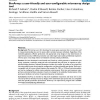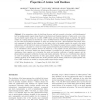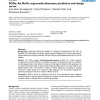451 search results - page 55 / 91 » SAT-based protein design |
BMCBI
2006
13 years 7 months ago
2006
Background: Microarrays were first developed to assess gene expression but are now also used to map protein-binding sites and to assess allelic variation between individuals. Rega...
DNA
2005
Springer
14 years 1 months ago
2005
Springer
Recent experimental progress in DNA lattice construction, DNA robotics, and DNA computing provides the basis for designing DNA cellular computing devices, i.e. autonomous nano-mech...
BMCBI
2007
13 years 7 months ago
2007
Background: In many contexts, researchers need specific primers for all sequences in a family such that each primer set amplifies only its target sequence and none of the others, ...
JCC
2007
13 years 7 months ago
2007
: It has tremendous values for both drug discovery and basic research to develop a solid bioinformatical tool for guiding peptide reagent design. Based on the physical and chemical...
BMCBI
2008
13 years 7 months ago
2008
Background: Superoxide dismutases (SODs) are ubiquitous metalloenzymes that play an important role in the defense of aerobic organisms against oxidative stress, by converting reac...



